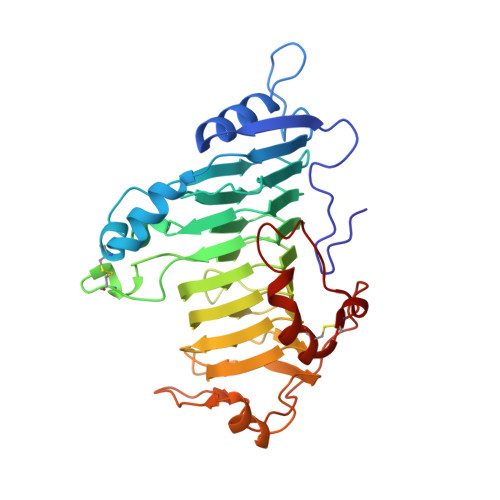Characterization and Implications of Ca2+ Binding to Pectate Lyase C
Herron, S.R., Scavetta, R., Garrett, M., Legner, M., Jurnak, F.A.(2003) J Biol Chem 278: 12271-12277
- PubMed: 12540845
- DOI: https://doi.org/10.1074/jbc.M209306200
- Primary Citation of Related Structures:
1O88, 1O8D, 1O8E, 1O8F, 1O8G, 1O8H, 1O8I, 1O8J, 1O8K, 1O8L, 1O8M - PubMed Abstract:
Ca(2+) is essential for in vitro activity of Erwinia chrysanthemi pectate lyase C (PelC). Crystallographic analyses of 11 PelC-Ca(2+) complexes, formed at pH 4.5, 9.5, and 11.2 under varying Ca(2+) concentrations, have been solved and refined at a resolution of 2.2 A. The Ca(2+) site represents a new motif for Ca(2+), consisting primarily of beta-turns and beta-strands. The principal differences between PelC and the PelC-Ca(2+) structures at all pH values are the side-chain conformations of Asp-129 and Glu-166 as well as the occupancies of four water molecules. According to calculations of pK(a) values, the presence of Ca(2+) and associated structural changes lower the pK(a) of Arg-218, the amino acid responsible for proton abstraction during catalysis. The Ca(2+) affinity for PelC is weak, as the K(d) was estimated to be 0.132 (+/-0.004) mm at pH 9.5, 1.09 (+/-0.29) mm at pH 11.2, and 5.84 (+/-0.41) mm at pH 4.5 from x-ray diffraction studies and 0.133 (+/-0.045) mm at pH 9.5 from intrinsic tryptophan fluorescence measurements. Given the pH dependence of Ca(2+) affinity, PelC activity at pH 4.5 has been reexamined. At saturating Ca(2+) concentrations, PelC activity increases 10-fold at pH 4.5 but is less than 1% of maximal activity at pH 9.5. Taken together, the studies suggest that the primary Ca(2+) ion in PelC has multiple functions.
Organizational Affiliation:
Department of Physiology and Biophysics, University of California, Irvine, California 92697-4560, USA.















